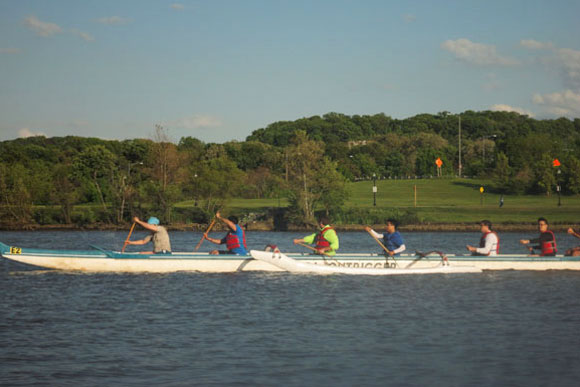There are more than 600,000 people living in Washington, D.C., but only a fraction of them have ever seen the Anacostia River up close.
Like,
really up close. From the seat of a kayak, canoe or rowboat.
If you're on a high school crew team you may practice on the Anacostia. If you own your own boat, maybe you've come here. But there's no place to launch a rented boat into the Anacostia in Washington, so most District residents paddle elsewhere. Besides, if you don't know any better, the Anacostia is probably the last place on Earth you'd want to stick your paddle.
Unless you're a member of the
Capital Rowing Club,
DC Strokes or the
National Capital Area Women's Paddling Association, three groups that spend more time on the water weekly than most people do--ever.
It was with the last group--NCAWPA, which is open to both genders--that I tagged along during a recent practice. NCAWPA fields both
dragonboat and
outrigger canoe teams and allows novices to come to practices on select nights.
Leading OC practice the day I went to novice night were husband and wife Matt Butcher and Liz Pennisi, who each took the back seat in an outrigger canoe and called commands to the paddlers. With twelve people all pulling ("huki," a Hawaiian word) at once, we zoomed downstream at a rapid clip.
That day the coaches were helping a relatively new team from the U.S. Patent and Trademark office train for an upcoming race.
For those who aren't immersed in it, the size of the watersport community in and around D.C. is pretty surprising. There are races, festivals, and more. The rapids at Great Falls are training grounds for Olympians. It's only a few hours to fairly decent (by East coast standards) surfing. "D.C. is a mecca for watersports," says Butcher.

From the boathouse near 19th and M SE, it's possible to paddle upstream as far as Bladensburg or downstream more or less forever. We pass Navy Yard and the baseball stadium. There are a few crew teams finishing up their practice, but besides those few boats, we're alone on the water. On the south bank, Anacostia Park's grassy banks are dead quiet. As we glide under bridges, cars pass overhead, but down in the water, it's hard to hear the roar of their engines. D.C. really does look different from down here.
An improving picture
The NCAWPA isn't an environmental organization, though its members do participate in periodic cleanups. You want the river you're using on a near-daily basis to be clean, after all.
Actually, the river is doing better than ever. Last year, the Anacostia Watershed Society gave the river a C minus in its annual river report card. Sounds bad, but it's a big improvement over the Fs the conservation organization handed out two years ago.
Green infrastructure like trees and green roofs capture stormwater before it runs into the river, bringing pollutants with it. Litter traps catch garbage to keep it out of the bellies of river life. The "Clean Rivers Project," which involves digging giant storage tunnels under D.C., should reduce the amount of sewage running into the Anacostia by 98 percent.
But, "after a rain," Pennisi says, "the river is full of garbage."
The day I went to outrigger canoe novice night was clear and sunny, and it hadn't rained recently. I hadn't been worried about that until Pennisi said something, and then my brain started filling with images of raw sewage flooding the boat. Yes, she'd said garbage, not sewage, but D.C.'s aging sewer system is (in places) a combined sewer outflow system, which means that after heavy rain, untreated sewage flows straight into the river instead of making a stop at the Blue Plains Wastewater Treatment Plant—two billion gallons of sewage enter the river yearly.
Only one Styrofoam cup floated past in the whole 90 minutes or so we were outside.
Maybe I needn't have worried. Yes, it's still
unsafe to eat fish from the river, and while it's nowhere near
catching fire there's still work to do. People shouldn't swim in the river or (god forbid) drink it. But on the cool spring evening I went out to paddle, the water at least
looked (and smelled) beautiful, refreshing, clean. I saw birds, insects, fish. Only one Styrofoam cup floated past in the whole 90 minutes or so we were outside.
Butcher recalls a time when he must have startled a large gar. He holds his hands out to show how big it was--two feet or more. The fish began jumping and almost landed in the boat. "Scared the bejesus out of me," he says.
There are
large fish in the Anacostia?
Butcher says that for a time, water quality test results were being sent to the club on a regular basis. He says he wouldn't stop anyone from skipping practice on a day that the water was given a poor grade, but most members are more concerned about getting a good workout and being prepared for the next race. "We're not the Excuse Not To Paddle Club." (Pennisi, who has a degree in biology, is similarly enthusiastic about getting people to look past the river's reputation.)
"The information out there is doom and gloom," Butcher says. "This is the river that we have. Let's use it."
The NCAWPA's outrigger canoe novice nights are Mondays; contact the group to sign up for a practice. The Anacostia Watershed Society also hosts canoeing and kayak nights; click here for more info.